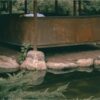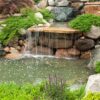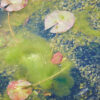Planters consider Creeping Jenny Pond Plants not only a favorite but also the ideal filler around waterfalls because of their green spring color.
Plants like Creeping Jenny are excellent water gardening candidates. They are well-known as groundcovers or as accents in containers. Several of its three glossy, round Chartreuse leaves cling to the stem, creating an appealing chain that cascades over tub sides or trails along rocks at the bottom of a pond.
Rooting Creeping Jenny In Water
As a marginal plant in the water garden, the Creeping Jenny loves moist soil or a dense covering of water. Its bright, cheerful leaves make a stunning contrast between wet stone, which is gray and cool, and Creeping Jenny, growing to about two inches in height. Summer is full of tiny, delightful yellow flowers, adding a touch of beauty to the flower garden.
Alternatively, best for hanging baskets, window boxes, and containers to fill spaces around waterfalls and rocks. Creeping Jenny works well in areas where it can cascade over walls or banks.
How To Grow Creeping Jenny Pond Plants
Adding plants loosely to your planting containers (which contain your preferred aquatic cultivation medium) is the most effective planting method. Place the plant into the pot, leaving ample space for its roots to spread over the soil. Fertilize the bottom half of the planting medium. Up to two-thirds of the way up, you can add more media.
Most plants have a crown that extends as far below the surface of the planting medium as their roots and stems.
Creeping Jenny works best in shallow water up to two inches deep into your pond. In addition to holding pond fish and insects, this habitat will also house frogs.
If you must use potting soil, you should not use bagged potting mix, as it has a high floating tendency and may muddy the water.
How To Trim Creeping Jenny Pond Plants
Once your creeping jenny plants bloom and start budding brown or yellow leaves, you may need to trim or prune them. If they are removed completely, excess organic material will be minimized in the water.
Stems and leaves begin to die off once winter arrives. The dead foliage of plants planted directly in bogs should only be trimmed to a height of 1-2 inches above the surface of the water. It is a good idea to trim the dead foliage of plants in plant pots and on plant shelves before lowering them carefully into the pond.
During winter, get out your submerged plants as soon as the ice begins to thaw, especially before they grow into tall plants. Plants will not be harmed if you leave them in place in zones 6 and warmer, and you do not need to move them.
Will Creeping Jenny Kill Other Plants
There are many types of Creeping Jenny, and some consider it to be very invasive. It can easily be removed and managed quite well. Its trailing foliage floats in the water, creating an enchanting texture among the rocks at the edge of the pond. The low-maintenance charmer grows well in a gentle stream or lets it tumble down the side of a waterfall as a visual treat.
The plant provides medical care as well as aesthetic appeal. Lysimachia is great to treat urinary bladder stones and gall stones in traditional Chinese medicine. A number of phenolic acids are present in the plant, which is POPULAR to treat wounds by herbalists. Some practitioners also use it to combat gout symptoms.
As an evergreen groundcover, it thrives in shade, moist (or even soggy) areas where few other plants will grow. Keeping it contained around stepping stones will make it withstand light trampling. Streams and pools, as well as wet banks, are ideal habitats for it.
Is it possible to grow Creeping Jenny in water?
Yes, it’s possible to plant creeping jenny in water. A 2 inch depth of moist soil or water is the ideal growing environment for this pond plant. Having creeping jenny as a marginal plant would make a great addition to a water garden.
What is the spread rate of Creeping Jenny?
You can expect the spread of growth in a season to reach 18 inches (or more).
How much sun and shade does Creeping Jenny require?
Climbing Jenny grows best in partial shade to full sun.










